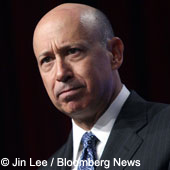
|

|
Did Goldman Goose Oil?
Christopher Helman and Liz Moyer
Forbes Magazine
April 13, 2009
How Goldman Sachs was at the center of the oil trading fiasco that
bankrupted pipeline giant Semgroup.
| 
Lloyd Blankfein's Goldman Sachs turned up everywhere (Jin Lee/Bloomberg News) |
When oil prices spiked last summer to $147 a barrel, the biggest corporate casualty was oil pipeline giant Semgroup Holdings, a $14 billion (sales) private firm in Tulsa, Okla. It had racked up $2.4 billion in trading losses betting that oil prices would go down, including $290 million in accounts personally managed by then chief executive Thomas Kivisto. Its short positions amounted to the equivalent of 20% of the nation's crude oil inventories. With the credit crunch eliminating any hope of meeting a $500 million margin call, Semgroup filed for bankruptcy on July 22.
But now some of the people involved in cleaning up the financial mess are suggesting that Semgroup's collapse was more than just bad judgment and worse timing. There is evidence of a malevolent hand at work: oil price manipulation by traders orchestrating a short squeeze to push up the price of West Texas Intermediate crude to the point that it would generate fatal losses in Semgroup's accounts.
"What transpired at Semgroup was no less than a $500 billion fraud on the people of the world," says John Catsimatidis, the billionaire grocer turned oil refiner who is attempting to reorganize Semgroup in bankruptcy court. The $500 billion is how much the world would have overpaid for crude had a successful scam pushed up oil prices by $50 a barrel for 100 days.
What's the evidence of this? Much is circumstantial. Proving oil-trading manipulation is difficult. But numerous people familiar with the events insist that Citibank, Merrill Lynch and especially Goldman Sachs had knowledge about Semgroup's trading positions from their vetting of an ill-fated $1.5 billion private placement deal last spring. "Nothing's been proven, but if somebody has your book and knows every trade, it would not be difficult to bet against that book and put the company into a tremendous liquidity squeeze," says John Tucker, who is representing Kivisto.
What's known for sure is that Goldman Sachs, through J. Aron & Co., its commodities trading arm, was in prime position to use such data--and profited handsomely from Semgroup's fall. J. Aron was Semgroup's biggest counterparty, trading both physical oil flowing through pipelines and paper oil, in the form of options and futures.
When crude oil peaked in July, Semgroup ran out of cash to meet margin requirements on options contracts it had with Aron, contracts on which it had paper losses of $350 million. Desperate to survive, Semgroup asked Aron to pony up $430 million it owed on physical oil. Aron said no, declared Semgroup in default on its contracts and demanded immediate payment of losses.
Some answers may emerge in late March when former FBI director Louis Freeh releases a report on the trading surrounding Semgroup's demise. He was hired by Semgroup and given subpoena power by the bankruptcy court judge in Delaware. Meanwhile the Securities & Exchange Commission is investigating, and lawyers involved in the bankruptcy say that Manhattan District Attorney Robert Morgenthau's office is looking into the actions of New York firms in the collapse. His office declines to comment.
Posted by Arthur Caldicott on 29 Mar 2009


